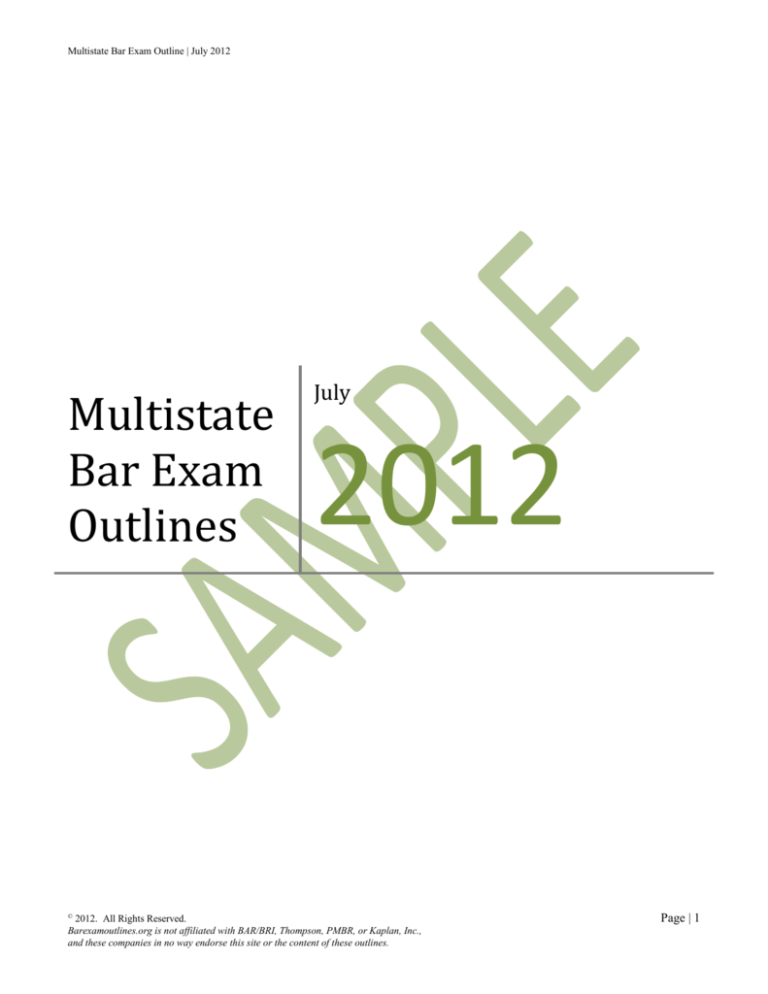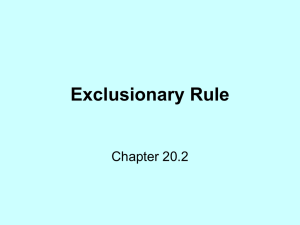
Multistate Bar Exam Outline | July 2012
Multistate
Bar Exam
Outlines
©
July
2012
2012. All Rights Reserved.
Barexamoutlines.org is not affiliated with BAR/BRI, Thompson, PMBR, or Kaplan, Inc.,
and these companies in no way endorse this site or the content of these outlines.
Page | 1
Multistate Bar Exam Outline | July 2012
Constitutional Law
I.
The Federal Judicial Power
a. Requirement for Cases and Controversies
i. Standing: whether the Plaintiff is the proper party to bring a matter to the court
1. Injury:
a. Ps may only assert injuries they have personally suffered
i.
Example: Sierra Club case to save lands from Disney
b.
b.
c.
©
Ps seeking injunctive/declaratory relief must show likelihood of future
harm to the Plaintiff himself (e.g., LA chokehold case)
2. Causation and Redressability: Plaintiff must allege that the Defendant caused injury
so that a favorable court decision will likely redress it
a. Rationale: prohibition of advisory opinions
3. No third party standing: Plaintiff cannot assert claims of others
a. Exception: allowed if there’s a close relationship b/t Plaintiff and injured
third party
b. Exception: allowed if the injured 3d party is unlikely to be able to assert
his/her own rights
c. Exception: organization may sue for its members if:
i. Members would have standing to sue
ii. The interests are germane to the organization’s purpose
iii. Neither the claim nor relief requires participation of individuals of
org.
4. No generalized grievances: Plaintiff cannot sue solely as a taxpayer or citizen
a. Example: Statement of Accounts case re: CIA books
b. Exception: taxpayers can challenge government expenditures as violating
the Establishment Clause
ii. Ripeness: whether federal court may grant pre-enforcement review of statute
1. Factors:
a. The hardship that will be suffered without pre-enforcement review
b. The fitness of the issues and the record for judicial review
2. Example: FDA generic labeling case; hardship = $$; fitness = purely question of law
iii. Mootness: case dismissed if events after filing the lawsuit end the Plaintiff’s injury
1. Must be a live controversy or ongoing injury
2. Exception: wrong capable of evading review (e.g., Roe v. Wage)
3. Exception: voluntary cessation (if D voluntarily stops, but is free to resume)
4. Exception: class action suits (if any one member of class has ongoing injury)
iv. Political Question Doctrine: federal courts won’t hear these types of cases:
1. The republican form of government (e.g., voter initiative process)
2. Challenges to the President’s conduct of foreign policy (e.g., treaties)
3. Challenges to the impeachment and removal process
4. Challenges to partisan gerrymandering
Supreme Court Review
i. Almost all cases come to the Supreme Court by writ of certiorari (discretionary review),
including those from state courts and US Courts of Appeals
1. Appeals from decisions of 3-judge federal district courts not discretionary
2. Supreme Court has original & exclusive jurisdiction for suits between states
ii. Supreme Court may only hear cases after final judgment of highest state court
iii. To hear state decision, may not be independent and adequate state law ground of decision.
Thus, Supreme Court reversal of federal law ground must change result.
Lower Federal Court Review
i. Federal courts (and state governments) may not hear suits against state governments
1. Sovereign immunity:
a. 11th Amendment bars suits against states in federal court,
b. Sovereign immunity bars suits against states in state courts
2012. All Rights Reserved.
Barexamoutlines.org is not affiliated with BAR/BRI, Thompson, PMBR, or Kaplan, Inc.,
and these companies in no way endorse this site or the content of these outlines.
Page | 2




![[2012] NZEmpC 75 Fuqiang Yu v Xin Li and Symbol Spreading Ltd](http://s3.studylib.net/store/data/008200032_1-14a831fd0b1654b1f76517c466dafbe5-300x300.png)



